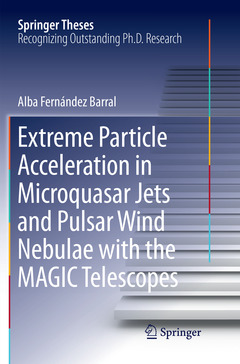Description
Extreme Particle Acceleration in Microquasar Jets and Pulsar Wind Nebulae with the MAGIC Telescopes, Softcover reprint of the original 1st ed. 2018
Springer Theses Series
Author: Fernández Barral Alba
Language: English
Subject for Extreme Particle Acceleration in Microquasar Jets and...:
Approximative price 105.49 €
In Print (Delivery period: 15 days).
Add to cartPublication date: 02-2019
Support: Print on demand
105.49 €
In Print (Delivery period: 15 days).
Add to cartPublication date: 10-2018
Support: Print on demand
Description
/li>Contents
/li>Biography
/li>Comment
/li>
This exhaustive work sheds new light on unsolved questions in gamma-ray astrophysics. It presents not only a complete introduction to the non-thermal Universe, but also a description of the Imaging Atmospheric Cherenkov technique and the MAGIC telescopes. The Fermi-LAT satellite and the HAWC Observatory are also described, as results from both are included. The physics section of the book is divided into microquasars and pulsar wind nebulae (PWNe), and includes extended overviews of both.
In turn, the book discusses constraints on particle acceleration and gamma-ray production in microquasar jets, based on the analyses of MAGIC data on Cygnus X-1, Cygnus X-3 and V404 Cygni. Moreover, it presents the discovery of high-energy gamma-ray emissions from Cygnus X-1, using Fermi-LAT data. The book includes the first joint work between MAGIC, Fermi-LAT and HAWC, and discusses the hypothetical PWN nature of the targets in depth. It reports on a PWN population study that discusses, for the first time, the importance of the surrounding medium for gamma-ray production, and in closing presents technical work on the first Large-Size-Telescope (LST; CTA Collaboration), along with a complete description of the camera.Nominated as an outstanding PhD thesis by the Universitat Autònoma de Barcelona, Bellatara, Spain
Presents an extensive overview of various gamma-ray detection techniques, focusing on imaging atmospheric Cherenkov telescopes, and complete descriptions of the MAGIC telescopes
Provides a state-of-the-art overview of production mechanisms and sites for very-high-energy gamma rays inside microquasar jets and the absorption effects on these emissions
Includes a detailed discussion of the possible pulsar wind nebula (PWN) nature of unassociated TeV sources, and the relation between the surrounding photon field density and very-high-energy gamma-ray emissions from this type of system




